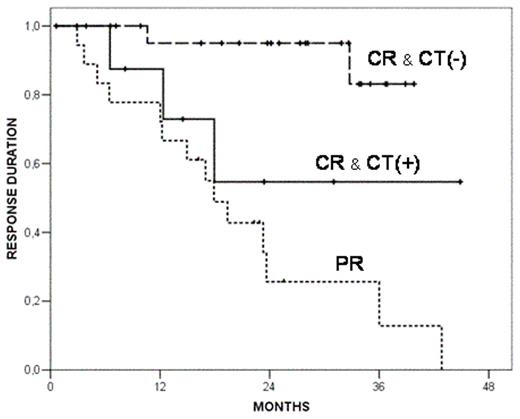Abstract
Imaging studies are not routinely performed to evaluate response to therapy in patients with CLL. To ascertain whether CT scans should be part of the maneuvers to assess response in patients with CLL we have investigated response duration according to CT results in 34 previously untreated patients (median age, 56 years; range, 38 to 65 years; males: 79%) uniformly treated with FCM (fludarabine 25 mg/m2 i.v. on days 1 to 3, cyclophosphamide 200 mg/ m2 on days 1 to 3, and mitoxantrone 6 mg/m2 i.v. on day 1, given at a 4-week intervals up to six courses) as part of a phase II study. Out of 69 patients included in the study, 64% achieved CR as defined by the NCI-Working Group criteria. Of those, 30% had abdominal lymphadenopathy as assessed by CT scans. The median follow-up of the series was 30 months. As shown in the figure, response duration was significantly shorter (54% at 20 months) in CR patients with abnormal CT (CT+ CR) than in those with no detectable lymphadenopathy (CT- CR) (95% at 20 months). Interestingly, response duration in patients with CT+ CR was not different from that of patients in PR (54% vs. 42% at 20 months, respectively; p=NS). These results demonstrate that residual abdominal lymphadenopathy negatively influences response duration in patients with CLL in whom by all other criteria a CR has been obtained. Therefore, CT scans should be performed in patients having achieved CR by conventional, NCI-Working Group criteria, and patients with residual disease by CT should be considered in PR rather than in CR.
Disclosure: No relevant conflicts of interest to declare.
Author notes
Corresponding author


This feature is available to Subscribers Only
Sign In or Create an Account Close Modal